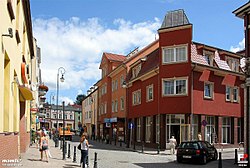Bytów
| Bytów | ||||
|---|---|---|---|---|
Old Town (top) and Teutonic castle (bottom)
|
||||
|
||||
| Coordinates: 54°8′N 17°30′E / 54.133°N 17.500°E | ||||
| Country | Poland | |||
| Voivodeship | Pomeranian | |||
| County | Bytów County | |||
| Gmina | Gmina Bytów | |||
| Established | 12th century | |||
| Town rights | 1346 | |||
| Government | ||||
| • Mayor | Ryszard Sylka | |||
| Area | ||||
| • Total | 8.72 km2 (3.37 sq mi) | |||
| Population (2006) | ||||
| • Total | 16,715 | |||
| • Density | 1,900/km2 (5,000/sq mi) | |||
| Time zone | CET (UTC+1) | |||
| • Summer (DST) | CEST (UTC+2) | |||
| Postal code | 77-100 | |||
| Area code(s) | +48 59 | |||
| Car plates | GBY | |||
| Website | http://www.bytow.com.pl | |||
Bytów [ˈbɨtuf] (Kashubian: Bëtowò; German: Bütow (![]() listen) is a town in the Gdańsk Pomerania region of northern Poland with 16,888 inhabitants (2004). Previously in Słupsk Voivodeship (1975–1998), it is the capital of Bytów County in Pomeranian Voivodeship (since 1999).
listen) is a town in the Gdańsk Pomerania region of northern Poland with 16,888 inhabitants (2004). Previously in Słupsk Voivodeship (1975–1998), it is the capital of Bytów County in Pomeranian Voivodeship (since 1999).
The origins of Bytów can be traced back to the early Middle Ages when a fortified stronghold once stood near the town. Bytów was later mentioned, under the Latin name castrum nomine Bitom, by notable Gallus Anonymus in his Chronicles describing medieval Poland. During the Thirteen Years' War (1454-1466), Bytów was the sight of heavy fighting and changed hands over time. Eventually, King Casimir IV Jagiellon granted the town to Eric II, Duke of Pomerania, as a perpetual fiefdom. After the Partitions of Poland, Bytów became part of German Prussia and remained in Germany until the end of World War II. At the final stages of the war, Bytów was the center of heavy artillery shelling initiated by the Red Army; as a result over 55% of buildings were destroyed.
...
Wikipedia





